“What is the origin of the universe? This very simple question lies at the heart of all your work and forms the basis of the ambitions for the Future Circular Collider study.” – José van Dijck, president of the Royal Netherlands Academy of Arts and Sciences.

It is almost six years since the CMS and ATLAS collaborations jointly announced the discovery of the Higgs boson, the last of the Standard Model particles predicted to exist. Yet deep questions in particle physics remain unsolved and precise measurements of the Higgs boson are one of many ways to search for answers that could point to new physics beyond the Standard Model. Experiments at higher energies than those available at the LHC could conclusively determine which, if any, of the many theories describing this new physics is realised and reveal the nature of the dark sector of the universe.
The Future Circular Collider (FCC) study, which was formally launched in 2014, would see a 100 km-circumference tunnel built at CERN to host post-LHC colliders. The goals of this international project include precision measurements of the Higgs self-interaction, whose structure is deeply related to the origin of mass and to the breaking of the electroweak symmetry. More generally, the FCC offers a leap into completely uncharted territory, from delivering mind-boggling statistics of 5 × 1012 Z decays all the way up to proton–proton collisions at an energy of 100 TeV (CERN Courier May 2017 p34).
Deriving from proposals formulated as early as 2010, the FCC study has made rapid progress in R&D across the many domains of this mammoth technological effort, and attracted a growing international community. Scientists and engineers from around the world gathered in Amsterdam from 9–13 April for the 2018 FCC collaboration week to identify key objectives for the FCC’s Conceptual Design Report (CDR), which is due by the end of this year. Advances in theoretical studies and detector techniques presented during the conference demonstrated that the machines envisaged by the FCC study could investigate some of the most compelling issues of particle physics in the decades following the LHC, while at the same time driving a major training, technological and industrial programme.
As with other major proposals for post-LHC machines at CERN and elsewhere, the FCC is currently at the exploratory stage. Its predecessors, the Large Electron Positron collider (LEP) and the LHC were, and are, massive endeavours offering a fruitful physics programme spanning more than 60 years: from the first concept of LEP to the future full exploitation of the high-luminosity LHC upgrade. The timescales of high-energy physics are such that we need to start the process of designing, and understanding what would be required to build, the next generation of circular colliders now if they are to come into operation soon after the completion of the high-luminosity LHC’s research programme in the late 2030s.
Following earlier investigations and projects – such as the ELOISATRON in Italy and the Superconducting Super Collider and Very Large Lepton Collider (VLLC)/Very Large Hadron Collider (VLHC) in the US – the first studies in Europe for a future circular collider started in 2010 and 2011, respectively, for new high-energy proton and lepton colliders at CERN. The lepton collider had three variants: LEP3 (a new electron–positron collider in the LHC tunnel), DLEP (a new collider roughly double the size of LEP) and the 80 km circumference “TLEP” (triple the size of LEP). As was the case for LEP and LHC, and also proposed by the VLLC/VLHC study in around 2001, both the lepton and hadron machines could be housed successively in a new, large tunnel.
Amalgamation
In early 2014 the lepton- and proton-collider design efforts were formally combined under the umbrella of the FCC study. First civil engineering studies in 2012 and 2014 revealed that a tunnel of 80–100 km is geologically preferred in the Lake Geneva basin, and a circumference of about 100 km has become the FCC target. In 2013 the Institute for High-Energy Physics in Beijing initiated a similar design study for a Higgs factory in China (CEPC) that would be succeeded by a high-energy proton–proton collider called SppC (see China’s bid for a circular electron–positron collider). Initially a CEPC tunnel circumference of 54 km and a proton collider reaching collision energies of 70 TeV were being considered, but since 2017 the CEPC tunnel circumference has also been set at 100 km.
The FCC study envisages, as a potential first step, an electron–positron collider (FCC-ee) that could scrutinise the Higgs boson and the electroweak scale. The remarkable precision of LEP has been instrumental in confirming the Standard Model and in tightly constraining the masses of the top quark and of the Higgs Boson. The FCC-ee builds upon this tradition. Operating at four different energies for precision measurements of the Z, W and Higgs bosons and the top quark, FCC-ee represents a significant advance in terms of technology and design parameters. The total scientific programme could span a period of 14 years, the first eight dedicated to Z, W and Higgs measurements followed by a high-energy upgrade to a top-quark factory.
With produced samples of 5 × 1012 Z bosons, 108 W pairs, 106 Higgs and top pairs, FCC-ee will allow searches for rare phenomena that can reveal new physics, while as an exploratory machine it would have sensitivity to new particles that might either be extremely heavy or that could interact too weakly with ordinary matter to be otherwise seen. The extraordinary precision of FCC-ee (1 ppm precision on the Z mass, 7 ppm precision on the W mass) backed up by unique measurements of additional inputs to the calculations (such as the top-quark mass) will allow typical sensitivity to particles as massive as 50 TeV or to couplings many orders of magnitude smaller than those of normal particles. While presenting considerable challenges, the design and technology for FCC-ee are solid and the machine could be built so as to start physics as soon as the LHC’s high-luminosity upgrade (HL-LHC) has completed its programme.
The mammoth proton–proton collider (FCC-hh) would operate at seven times the LHC energy, and deliver about 10 times more integrated luminosity. During its planned 25 years of data-taking, more than 1010 Higgs bosons will be created, which will be 100 times more than that achieved by the end of the (HL-)LHC operation. These additional statistics will enable the FCC-hh experiments to improve the separation of Higgs signals from the huge backgrounds that affect most LHC studies. The discovery reach for high-mass particles – such as Z′ and W′ gauge bosons corresponding to new fundamental forces, or particles like gluinos and squarks that appear in supersymmetric theories – will increase by a factor five or more, depending on the luminosity. The new energy regime will allow us to exclude many theories relying on weakly interacting massive particles, guaranteeing a discovery or excluding a vast portion of the parameter space, and explore fully the electroweak symmetry-breaking mechanism.
Operating the FCC-hh machine with heavy ions generates even more extreme collisions, leading to the creation of a quark–gluon plasma with larger initial density and temperature than those previously observed at RHIC and LHC. This system, in comparison to that produced at the LHC, represents the universe at an earlier, hotter stage of its evolution, allowing a better understanding of quantum chromodynamics and shedding light on the question of how quarks combine to form more stable particles. The FCC complex could also host a proton–electron mode (FCC-he) to explore the secrets of the structure of matter by means of an electron super microscope using deep-inelastic electron–proton (ep) scattering with unprecedented energies and luminosities. Finally, the FCC study also pursues the design of a 27 TeV proton–proton collider in the LHC tunnel (the so-called High Energy LHC, HE-LHC) based on the same 16 T superconducting niobium-tin magnet technology as intended for FCC.
New thinking required
Conceiving and designing an FCC-class accelerator poses tantalising challenges with respect to infrastructure and operations. Since the launch of the study, a major focus of the civil-engineering team has been locating the machine in the optimal position, as well as developing a design that could host the different collider modes in a combination of underground and surface structures.

The civil-engineering requirements for the FCC include approximately 115 km of tunnelling, of which 97.75 km is a 5.5 m-diameter machine tunnel, and the remainder is a combination of bypass, injection and dump tunnels. In addition, four experimental caverns and 12 service caverns are needed, while a total of 22 shafts will connect the underground facilities with the surface (figure 1). The current baseline position successfully fulfils many of the desired criteria, such as a reduction in the total shaft length, a maximum amount of tunnelling in the stable molasses rock, and a minimum amount of excavation in karstic limestone and moraines. Detailed underground surveys, as previously done for the LHC and HL-LHC, are needed to confirm the different soil types and identify potential problems before the proposed location can be firmly validated.
Significant progress has been made over the past year to assess and minimise environmental impact, opting for smart “green” solutions based on the development of new technologies. Among all proposed, future electron–positron colliders, FCC-ee offers by far the highest luminosity at the lowest electric input power up to the top quark threshold, partly thanks to more efficient superconducting radio-frequency cavities, new klystrons and novel designs for the dipole (figure 2) and quadrupole magnets. Similar considerations apply to the design of FCC-hh, which spans a wide range of proton collision energies yet should draw a total electric power similar to the FCC-ee.

FCC Week 2018 saw significant progress in the development of detector designs both for FCC-ee and FCC-hh. For the lepton collider, a detector inspired by the Compact Linear Collider (CLIC) with an all-silicon tracker and a 3D-imaging calorimeter, and an alternative novel detector approach (called International Detector for Electron-positron Accelerator, or IDEA) combine different philosophies with bold technologies. For IDEA, the vertex detector would be silicon-based using the Monolithic Active Pixel Sensor (MAPS) technology developed for the ALICE inner-tracker upgrade, while a large wire chamber inspired by DAFNE’s KLOE experiment would provide the central tracking. Perhaps the most innovative concept of IDEA is the dual-readout copper calorimeter. All in all, the basic detector components are based on proven techniques and work is in progress, including test beam sessions foreseen at CERN in the summer, to optimise their designs.
The increased energy of FCC-hh also has a huge impact on the design of the various detectors for tracking and calorimetry and their readout electronics, as well as the magnet system for bending charged particles and identifying their properties. The superconducting detector magnets of the FCC-hh experiments should provide a higher magnetic field over a larger tracking distance than currently achieved by the LHC experiments, and this poses a new challenge for magnet designers. The FCC-hh baseline design foresees a very large main solenoid (with a free bore of 10 m and a length of 20 m) providing a field of 4 T and forward solenoids at both ends. For FCC-ee, an ultra-thin 2 T magnet concept is being studied with a free bore of 4.4 m and a length of 6 m.
Core technology
Advanced superconducting technology is at the core of the FCC study. Two of the major technological challenges for an energy-frontier machine are the development of more powerful dipole magnets (16 T, which is around twice that of the LHC) and a new generation of superconductors able to meet the FCC requirements. CERN has launched a 16 T magnet programme, in coordination with a US programme targeting 15 T, and an ambitious FCC conductor development programme with research institutes and industry distributed around the world (CERN Courier May 2018 p40).
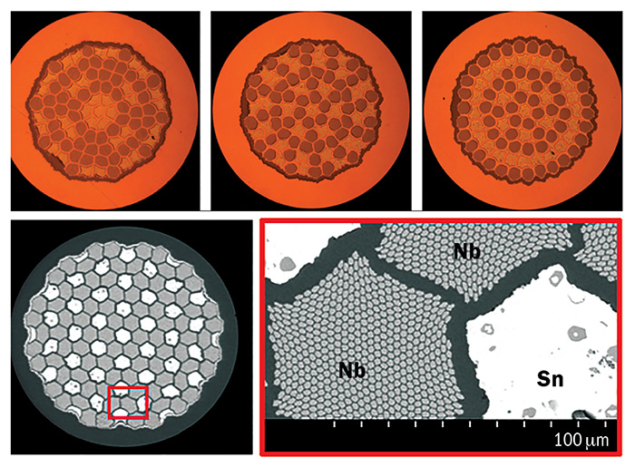
Niobium-tin (Nb3Sn) is the workhorse of the FCC magnet development programme. The first breakthrough results of this effort came in 2015, when a Nb3Sn magnet in Racetrack Model Coil (RMC) configuration reached a field of 16.2 T (CERN Courier November 2015 p8). The next goal is to create an enhanced RMC (ERMC) reaching a mid-plane field of 16 T with a 10% margin at a temperature of 4.2 K. The first ERMC coil was successfully wound at CERN in April this year (figure 2, left picture) and a demonstrator unit will be available by the end of the summer. The high-field magnets of the proposed FCC-hh collider would require 7000–9000 tonnes of Nb3Sn superconducting wire, with major implications for the superconductivity industry, while boosting the applications of this technology in domains outside high-energy physics.
The FCC conductor development programme aims, over an initial four-year period, to meet the challenging requirements of the FCC high-field magnets. The first results are very promising: within only one year, the Nb3Sn superconducting wires produced by various international partners have achieved the same performance as the HL-LHC wire (figure 3), and there are strong indicators that it will be feasible to meet the even more ambitious wire targets (in terms of performance and cost) for FCC. The FCC magnet development programme will require six tonnes of superconducting wire over the next five years for the construction of R&D and model magnets, representing a substantial opportunity for wire manufacturers in Europe and beyond. CERN has also launched a Marie-Curie training network called EASITrain to advance our knowledge on superconducting materials and take into account large-scale industrialisation (CERN Courier September 2017 p31).
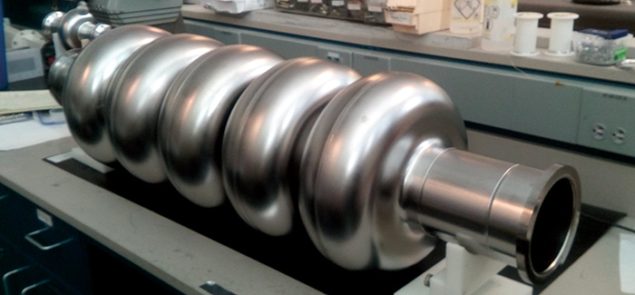
Another key technology for FCC is advanced superconducting radio-frequency (RF) cavities. A series of cavity designs comprising single-cell, four-cell 400 MHz and five-cell 800 MHz cavities are being developed, in collaboration with LNL-INFN in Italy and JLAB in the US, to cover the different operation energies foreseen for FCC-ee (figure 4). Recent progress in superconducting RF cavities at CERN has been fascinating, and a concrete R&D programme is under way (CERN Courier April 2018 p26). The technology of superconducting niobium-coated copper cavities, already employed at LEP and LHC, is rapidly advancing, achieving, for FCC-ee, a performance at 4.5 K that is competitive to niobium radiofrequency cavities at 2 K.
Current results from niobium-copper cavities installed in HIE-ISOLDE demonstrate the outstanding performance of this technology, achieving peak surface fields of 60 MV/m. Another key development is the rapid shaping of cavities using novel hydro-hydraulic forming, a technique developed in collaboration with the France-headquartered firm Bmax, and promising results from sputtering tests with Nb3Sn films for even more efficient RF cavities. In addition, new klystron bunching technologies that can increase RF power production efficiency up to 90% (compared to the present average of 65%) are being developed in collaboration with the CLIC team. Finally, prototypes of the low-field low-power (and low-cost) twin-aperture dipole and quadrupole magnets for the FCC-ee arcs have been built and tested at CERN.
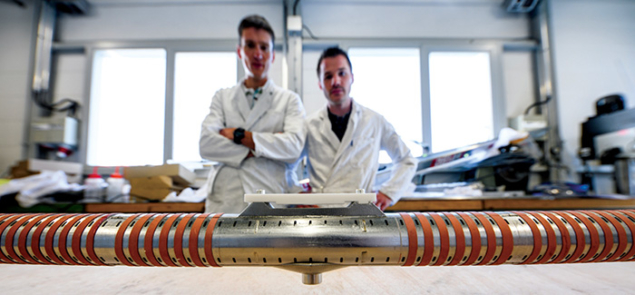
All in all, the new challenges of the FCC compared to the LHC and LEP call for a number of novel, special technologies that will allow a reliable and sustainable operation. New extraction systems, kickers and collimators to control the beam, powerful vacuum systems and novel approaches to deal with beam effects at the new regime of FCC, are but a few examples. These efforts have already resulted in a new beam-screen design (figure 5) to cope with the high synchrotron radiation of energetic proton beams, the first prototypes of which are currently under test at the Karlsruhe Research Accelerator (KARA) in Germany. Among other first pieces of hardware paving the way for FCC are the first prototypes of a superconducting shield septum magnet (figure 6) and an innovative method of laser surface treatment to suppress the electron clouds so easily induced by the intense FCC-hh beams, which is also under consideration for the HL-LHC.
Cooling the detector and accelerator magnets is another major challenge for a research infrastructure of this size, requiring huge cryogenic refrigeration capacity below 2 K. In collaboration with specialised industrial partners, significant studies of turbo compressors and also new mixtures of coolants have been carried out. A prototyping phase is to be launched after the completion of the forthcoming CDR.
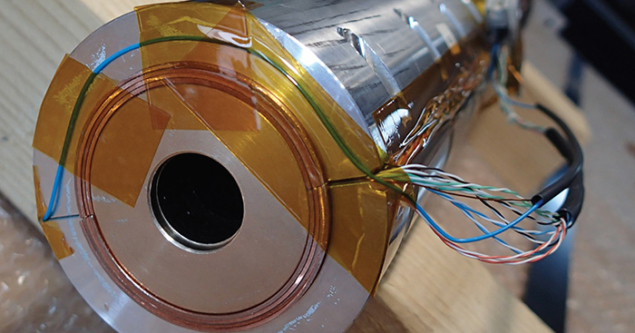
Winning multinational cooperation
A collider that significantly extends the energy reach of the LHC requires multi-year and multinational cooperation, given the daunting magnitude of the resources needed. The high and growing number of young participants during the annual FCC meetings is a positive indicator for the future of the study. Moreover, the participation of a large number of industries in the FCC study and the supporting Horizon 2020 projects is not a surprise. After all, many of these challenges are also opportunities for technological breakthroughs, as confirmed by past large-scale scientific projects.
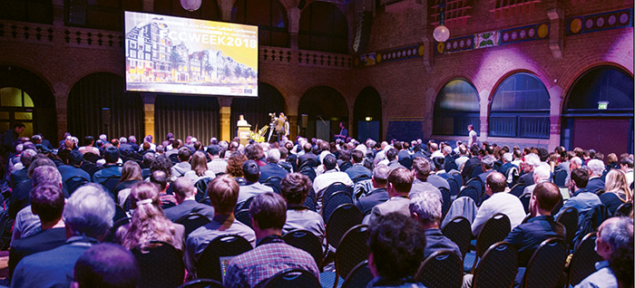
The wealth of results presented during the FCC Week 2018 will help inform the update of the European Strategy for Particle Physics, written input for which is required by the end of the year (CERN Courier April 2018 p7). As CERN Director-General Fabiola Gianotti remarked during the opening session of the Amsterdam event, “I cannot see a more natural and better place than CERN to host future circular colliders of the complexity of the FCC, given CERN’s demonstrated expertise in building and operating high-energy accelerators, the existing powerful accelerator complex, and the available infrastructure that we continue to upgrade.” The laboratory’s long history and strong expertise in all the necessary technical domains, as well as its ability to foster international collaborations that amplify the impact of such large-scale projects, provide the ideal base from which to mount the post-LHC adventure.
Further reading
A Blondel and F Zimmermann 2011 arXiv:1112.2518.
F Zimmermann 2013 EuCARD-REP-2013-008.
J Gao 2017 Int. J. Mod. Phys. A 32 1746003.
M Benedikt and F Zimmermann 2016 J. Korean Phys. Soc. 69 893.
M Mangano (ed.) 2017 arXiv:1710.06353.
M Bicer et al. 2014 J. High Energy Phys. 1 164.
J Ellis et al. 1998 CERN-SL-98-004-AP ; CERN-EP-98-003 ; CERN-TH-98-033.
T Sen and J Norem 2002 Phys. Rev. Spec. Top. Accel. Beams 5 031001.








